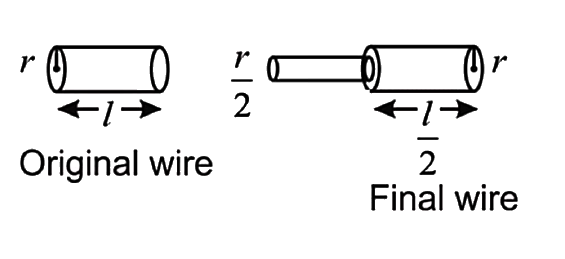The maximum load a wire can withstand without breaking, when its length is reduced to half of its original length, will
be double
be half
be four times
remain same.
The correct Answer is:D
To solve the problem of how the maximum load a wire can withstand changes when its length is reduced to half, we can follow these steps:
1. Understand the Concept of Stress and Load:
- Stress (σ) is defined as the force (F) applied per unit area (A) of the wire.
- Mathematically, it can be expressed as:
σ=FA
2. Identify the Relationship Between Load and Stress:
- The maximum load a wire can withstand before breaking is related to the material's tensile strength, which is a measure of the maximum stress the material can endure.
- Therefore, the force (or load) can be expressed as:
F=σ⋅A
3. Consider the Effect of Length on Stress:
- When the length of the wire is reduced to half, the cross-sectional area (A) remains unchanged because the diameter of the wire does not change.
- The tensile strength of the material is a property that depends on the material itself, not on its length.
4. Conclusion on Maximum Load:
- Since the tensile strength and the cross-sectional area remain constant, the maximum load the wire can withstand does not change when the length is halved.
- Thus, the maximum load remains the same as it was before the length was reduced.
Final Answer:
The maximum load a wire can withstand without breaking, when its length is reduced to half of its original length, will remain the same.
---
- Stress (σ) is defined as the force (F) applied per unit area (A) of the wire.
- Mathematically, it can be expressed as:
σ=FA
- The maximum load a wire can withstand before breaking is related to the material's tensile strength, which is a measure of the maximum stress the material can endure.
- Therefore, the force (or load) can be expressed as:
F=σ⋅A
- When the length of the wire is reduced to half, the cross-sectional area (A) remains unchanged because the diameter of the wire does not change.
- The tensile strength of the material is a property that depends on the material itself, not on its length.
- Since the tensile strength and the cross-sectional area remain constant, the maximum load the wire can withstand does not change when the length is halved.
- Thus, the maximum load remains the same as it was before the length was reduced.
The maximum load a wire can withstand without breaking, when its length is reduced to half of its original length, will remain the same.
Topper's Solved these Questions
- MECHANICAL PROPERTIES OF SOLIDSBook:NCERT FINGERTPS ENGLISHChapter:MECHANICAL PROPERTIES OF SOLIDSExercise:CORNER
Explore 15 Videos
- MECHANICAL PROPERTIES OF SOLIDSBook:NCERT FINGERTPS ENGLISHChapter:MECHANICAL PROPERTIES OF SOLIDSExercise:Hooke'S Law
Explore 3 Videos
- MECHANICAL PROPERTIES OF SOLIDSBook:NCERT FINGERTPS ENGLISHChapter:MECHANICAL PROPERTIES OF SOLIDSExercise:HOTS
Explore 8 Videos
- MECHANICAL PROPERTIES OF FLUIDSBook:NCERT FINGERTPS ENGLISHChapter:MECHANICAL PROPERTIES OF FLUIDSExercise:NCERT Exemplar
Explore 5 Videos
- MOTION IN A PLANE Book:NCERT FINGERTPS ENGLISHChapter:MOTION IN A PLANE Exercise:Assertion And Reason
Explore 15 Videos
Similar Questions
Knowledge Check
The volume of gas is reduced to half from its original volume. The specific heat will be
Abe reduced to halfBbe doubledCremain constantDbe increased four times
A 24 kg block resting on a floor has a rope tied to its top. The maximum tension , the rope can withstand without breaking is 310 N . The minimum time in which the block can be lifted a vertical distance of 4.6 m by pulling on the rope is
View SolutionWhen a piece of aliminium wire of finite length is drawn through a series of dies to reduce its diameter to half its original value, its resistance will become
View SolutionA metal wire of resistance 6Ω is stretched so that its length is increased to twice its original length. Calculate its new resistance.
View SolutionThe resistance of a wire is R ohm. What will be its new resistance if it is stretched to n times its original length ?
View SolutionThe volume of gas is reduced to half from its original volume. The specific heat will be
View SolutionWhat would be the change in radius of nth orbit, if the mass of electron reduces to half of its original value ?
View SolutionA wire of length l has a resistance R. If half of the length is stretched to make the radius half of its original value, then the final resistance of the wire is

View Solution
